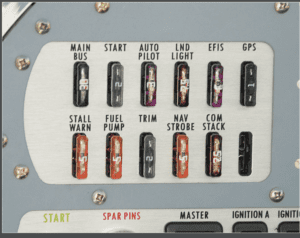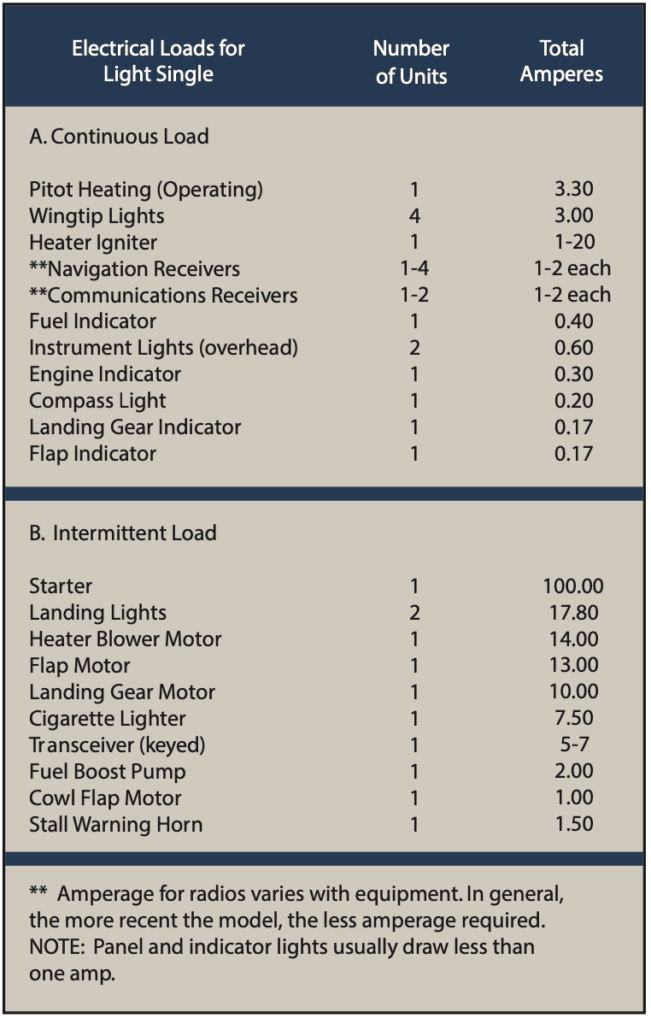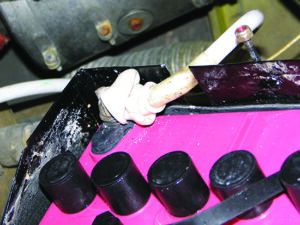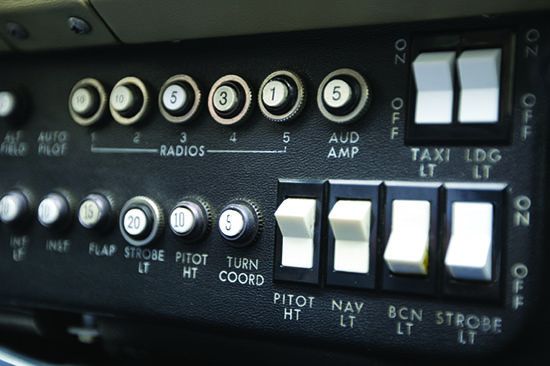The flight test was not going well. I was doing fine, which was easy because I was the check airman giving it. The guy I was testing, though, was having more trouble than expected. A few maneuvers were marginal, but so far none called for a failure. So far.
Next was an ILS approach. We were in instrument conditions, and I was paying close attention. As we approached glide slope intercept, I started doing less fine. He had not reduced power, so we were at cruise airspeed, about 30 knots too fast for putting the landing gear down. A check airman is not supposed to instruct, so I had to stay silent. But I didn’t want to leave landing gear parts strewn along the final approach course, either. so I pulled the landing gear circuit breaker. If he tried something funny the gear would not come down.
It worked: Nothing happened when he tried to put the gear down. It was still a bust—he violated an airspeed limitation—but only he was busted, not the airplane. We missed the approach and headed for the holding fix, but that’s another story.
ELECTRICAL SYSTEM BASICS
Every pilot’s operating handbook since 1976 has the same outline. For example, section 1 covers general information, Section 3 covers emergencies, section 4 covers abnormals, section 5 is performance and so forth. Section 7 has system descriptions, including electrical.
Most electrical systems have common elements: a storage battery, a way to recharge it and lots of ways to distribute energy to the devices needing it. The distribution is the complicated part.
Distribution devices are called “buses.” Most aircraft have several. Typically, there is a main bus, energized by the battery and attached to various devices. The master switch allows power to flow from the battery to the main bus. Avionics are usually on their own bus. And some aircraft have a separate bus that is always connected to the battery. And more….
ELCTRICAL SYSTEM FAILURE
Many aircraft components depend on electricity. What happens if the electrical system fails completely? Mechanical pitot-static instruments don’t use electricity, so a pilot still knows airspeed, altitude and vertical speed. Magnetos, also mechanical, keep electricity flowing to the spark plugs, and that keeps the engine or engines turning. Vacuum pumps attached to the engines mean that gyro instruments like attitude and heading indicators keep working, too. Presuming you haven’t gone all-electric, of course.
Navigation used to be a big problem in this situation, but if you have a device with an app like ForeFlight, you can get where you need to. If IFR, communications questions are answered by FAR 91.185, Two-way Radio Communications Failure. If VFR, an airplane without a comm radio must avoid some kinds of airspace, but even if going to an airport with a control tower, there are light gun signals.
One problem that can’t be handled in the airplane isn’t in the airplane at all: runway lights. Most airports have pilot-controlled lighting, activated by radio, but there are a few whose lights are on all the time. It would pay to know where these are.
Without electricity, your hands are full, but you can still keep the airplane right-side up. You may not have flaps, and you may need to use some kind of abnormal procedure to get the wheels down, but you can still keep the airplane right-side up.
Electronic flight instrument systems, EFIS, can destroy that whole picture. Without electricity, all of the flight instruments are blank. It’s not possible to control an aircraft at night or in instrument conditions without instruments. Some EFIS aircraft have backup pitot-static and vacuum instruments. Other EFIS aircraft use a separate electrical system to supply emergency power. This is called something like “standby” or “essential” power, with a separate battery and its own bus. The standby battery is kept charged by the main system.
If you’re in an EFIS airplane, one of the preflight checklist items should be a test of the standby system.

Most airplanes use circuit breakers for protection against electrical overloads. Fuses offer another form of protection. Advantages include they’re simpler to manufacture and have no moving parts. They’re lighter, too.
The big difference is that a fuse cannot be reset. Once it is tripped, you have to replace it. When this happens to your home furnace, you have to drive to the hardware store and buy a new one. But this bug may actually be a feature, because (and I can’t say this enough) resetting a circuit breaker is a big fire risk.
And fire is bad.
Many newer aircraft use fuses either in addition to CBs or alone for their circuit protection. It’s typical to carry extra fuses, but using one of them to replace a burned-out fuse sounds a lot like resetting a circuit breaker. And it may be difficult to do on a dark and stormy night.
MORE OR LESS
Electricity works great unless there is too much, or there is too little. The case of too little is less dangerous. An electrical appliance without electricity is useless. That’s why tech support’s first question is, “Did you plug it in?” The consequences might be dangerous, but the situation itself is not.
Too much electricity is dangerous.
A gizmo getting more electricity than it can handle has to convert it into some other kind of energy. Extra energy is generally converted into heat, and too much heat gets converted into fire. Fire is bad.
There are two ways to force too much electricity into something. One is by having something else on the same bus using a lot, because that energizes the whole bus. The other is to have electricity enter the circuit from someplace it shouldn’t.
Circuits are protected by circuit breakers, or CBs. If there is too much current, the CB turns the circuit off. It does this by “tripping” or “popping,” and you can see the popped circuit breaker jutting out from the CB panel.
Should you push a popped circuit breaker back in? The general answer is no. It might be that some random event caused it to pop, or there might be a real problem, the kind of problem that starts fires. If the system is in a safe configuration, like a landing gear CB tripping while the gear is down, leave it alone. If you really, really need the device that caused the CB to trip, pushing it in might cause a fire. Leave it alone. Circuit breakers are for pulling, not for pushing.
GETTING STARTED
The biggest electricity user in almost any aircraft is the starter. When the starter is engaged, everything else on its circuit gets the same huge amount of current. That’s probably too much for most avionics devices, which is why avionics should be off during start. Nowadays almost every aircraft has a separate avionics circuit, called a “bus,” and an avionics master switch that isolates the bus. Electronic engine instruments are an exception because they display instruments needed for starting.
There’s another bit of isolation protecting you from the starter. The starter switch is not connected directly to the starter. Instead the switch lets a small current flow to a solenoid, which is what actually sends electrons to the starter itself. The hand activating the starter is never near high current.
CUTTING THINGS SHORT
When electricity enters the circuit from someplace it shouldn’t, that’s called a short circuit. It’s not a very descriptive term, so think about the example of worn insulation. That covers a lot of situations. With the insulation gone, electricity flows somewhere it shouldn’t.
The effect can be dramatic. One night as I took the runway, I turned on the landing light. There was worn insulation in the landing light wiring. Smoke filled the cockpit immediately. A lot of smoke.
Where there is smoke there is fire. Fire is bad.
I turned the master switch off, and the smoke stopped. (“Master switch off” should be a memory item for an active electrical fire.) The checklist said to turn everything off, turn the master back on and then try turning things on one at a time. Position lights and radios caused no smoke as I slowly taxied back to parking without the landing light.

AC LIES, DC DIES?
There are two different kinds of electrical flow. Direct current (DC) takes power from the battery to ground, by way of the device it powers. It’s shooting electrons through a fire hose. You can think of alternating current (AC) as moving the power back and forth.
The study of AC and DC power is complicated, and there are a lot of reasons why a designer might choose one method over the other. What a pilot needs to know is how instruments react when the power disappears:
An AC-powered analog gauge freezes in position when the power stops. That’s the “lie.” A DC-powered needle indicates zero when the power’s gone: it dies.
The most dangerous case is electrically powered flight instruments. For example, many encoding altimeters are electrically powered. I’m not sure about the certification requirements, but every airplane I’ve flown that had an electrical altimeter also had either a barometric one, usually on the copilot panel, or a completely separate system like a copilot primary flight display. And every one I’ve seen has a “flag” that appears when the current stops.

A battery has a limited capacity, which is listed in section 7 of the POH. One common trainer has a 14 amp-hour battery, meaning that it can supply 14 amps of current for an hour, or seven for two hours, etc. Another popular high-performance single has two batteries, one rated at 10 amp-hours, the other at seven.
When no electricity is generated, the battery starts to run down. If the master switch is not on, that can take a long time. But many airplanes have items connected directly to the battery, bypassing the master. These are things like baggage lights, courtesy lights or even engine instruments. This is called something a “hot bus” or “essential bus.” Again, it’s in the POH. Leaving on a light connected to this bus over the weekend results in a dead battery.
Many cars have similar design features. My wife and I drive the same brand of car, but on mine the mirror adjustment is on the hot bus while on hers it’s on the main bus. She can’t adjust the mirrors until the battery is on.
In both, though, the vanity mirror is on the hot bus.
ALTERNATORS
There are two basic ways to generate electricity. All generators work by moving wires through a magnetic field, which induces a current. Where does the magnetic field come from? One choice is a permanent magnet, a heavy chunk of iron. “Heavy” and airplanes don’t mix. If there’s a permanent magnet, it’s called a generator. If instead there is some kind of electromagnet, it’s called an alternator.
An electromagnet needs power to generate the magnetic field. In alternator-equipped airplanes, the master switch is really two switches. One connects the battery to the rest of the system, and the other supplies power to the alternator. The alternator only needs a small amount of current, but if the battery is weak, turning the alternator off may make the difference between starting and not starting.
If the battery is completely dead (see the sidebar above), the alternator is useless. Hand-propping can get the engine running, but the alternator won’t produce electrical power. A generator will produce electrical power in this situation
REGULATING
Most generating systems can produce more electrical power than the airplane can use. Once the battery is fully charged and all of the appliances have the power they need, what happens to the extra power? Extra power means extra energy. Too much extra energy becomes heat. Too much heat becomes fire.
Have I mentioned that fire is bad?
So, systems have voltage regulators. One type adjusts output to match demand while the other turns the alternator or generator off when the power demand is met, and back on when power is needed. Voltage regulator failure can cause big problems, so even a Cessna 152 has a warning light. The POH’s emergency section has a checklist describing what to do when the light comes on. It does not have any memory items, so take the time to read it before acting. And think about it before you act.
One of the items is to turn the master switch off. This can be a problem at night, as one of my students discovered on a dual cross-country a couple of months ago. Luckily for him, I knew what was going to happen and had my flashlight ready. By the checklist, cycling the master and alternator switches should fix the problem. If it doesn’t, the checklist is clear: “Terminate the flight as soon as practicable.”
TOUCHDOWN
A Part 135 check airman is allowed, even encouraged, to stop the test and offer remedial instruction when a pilot fails a maneuver. Then the test starts again. The pilot taking the test and I went over the speed limitations and a few more things, making sure that at least for the next 15 minutes he would remember to slow down before selecting gear down. Which he did. I reset the CB I’d pulled, and the wheels went down correctly.
Sometimes stopping the electricity can save the plane.
Jim Wolper is an airline transport pilot and mathematics professor. He’s also a CFI with single-engine, multi-engine, instrument and glider ratings.





There is more wrong and misleading in this article than I can describe.
I’m an electrical engineer, pilot and aircraft owner, and there is a lot more to describing how and why we use circuit breakers and fuses, alternators vs DC generators, and how voltage regulators really work.
This article needs to be re-written with more accurate information and details.